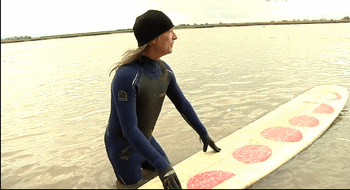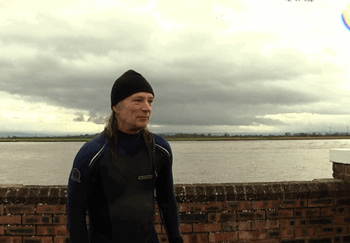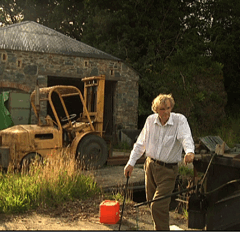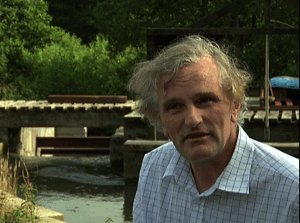Harnessing the Severn
Air Date: Week of November 20, 2009

Donnie Wright gets ready to catch the wave running up the Severn. (Photo: Tom Allan)
A tidal project that would put a 10-mile concrete barrier across the United Kingdom’s longest river is generating controversy. The proposed Severn barrage would help the UK produce reliable, renewable energy in its efforts to combat climate change. But critics say the huge tidal wall will harm the river ecosystem. Producer Tom Allan reports.
Transcript
YOUNG: It’s Living on Earth – I’m Jeff Young. This year the European Union passed ambitious new energy standards — 20 percent of total power from renewable sources by 2020. That’s a challenge for the United Kingdom, which is one of Europe’s worst performers on renewable energy. The UK government wants to tap into the country’s great potential for wind, wave, and tidal power. But proposals to harness the River Severn are so far generating mostly controversy.
At 220 miles, the Severn’s the UK's longest river. But what attracts clean energy engineers is the tidal action at the river’s mouth. Its estuary has the second greatest tidal range in the world. Capturing the energy of that tidal flow could meet five percent of the entire country’s electricity needs. But Tom Allan reports that some fear it could be disastrous for this renowned river.
[DAWN SOUNDS: BIRDS, WATER]
ALLAN: It's dawn on the banks of the River Severn in the Southwest of England. The river flows in sluggish channels past wide sand banks and shallow, muddy areas before emptying into the Bristol Channel, and then the Atlantic.
[DISTANT ROAR BEGINS TO BUILD]
ALLAN: There's a roar in the distance. Downstream, dozens of surfers and kayaks ride a wave.
This is no ordinary wave. This is the Severn bore, a tidal surge caused by the funnel shape of the Severn, and the enormous difference between its high and low tides - as much as fifty feet. The wave travels upstream, against the current.

Donnie Wright gets ready to catch the wave running up the Severn. (Photo: Tom Allan)
[CRESCENDO AS THE WAVE HITS]
WRIGHT: Too much wind that one ... but can't complain. Got a nice little ride while it lasted...
ALLAN: Donnie Wright has surfed the bore for fifteen years. With his long grey hair and black wetsuit, he looks like an otter.
WRIGHT: It's the loneliness of the experience. It's just you and nature.
ALLAN: It's clear that the Severn means more to Wright than just surfing.
He leans forward earnestly as he searches for the words to describe the iconic river.
WRIGHT: The Severn is a river, which has been flowing, determined by the tide, the diurnal tide, twice a day, in and out...the bed scars, the banks get flooded, fertilized. It is a magical place.
ALLAN: For Wright, the river is almost sacred – something to be treated with respect.
But for others, the river is a potential resource to be harnessed in the fight against climate change.
The UK Government is currently considering a number of renewable energy schemes for using the Severn. One of the main proposals is a barrage across the mouth of the river - a massive wall of concrete blocks ten miles long.

Surfer Donnie Wright. (Photo: Tom Allan)
When the tide comes in, the barrage would trap and hold the water, then release it through hundreds of turbines. Proponents say it would generate and average of 2,200 megawatts a year. That’s equal to a little more than two large power plants, and enough electricity for three million people - an enormous source of clean, predictable, renewable energy for the next century.
But to the dismay of some, it would halve the river’s tidal range, and end the run of the bore. Again, Donnie Wright.
WRIGHT: This River will just die. Put a barrage across like that, the barrage's effectiveness will not be a hundred years; it probably will only be ten years. It'll just silt the whole place up, and turn the whole place into a vast bog.
ALLAN: Critics of the barrage, point to the Bay of Fundy in Canada, the highest tidal range in the World. There, a small barrage caused both silting and coastal erosion. On the other hand, a barrage at La Rance in France has been a reliable source of energy for forty years, without silting.
Chris Morgan of the Severn Tidal Power Group, the consortium behind the UK barrage proposal, says silting shouldn't be a problem.
MORGAN: The sediment is moving continuously up and down the Severn Estuary, it's carried in on the high spring tide, and it’s carried out on the low spring tide. It's not predominantly coming down the rivers. Therefore creating a barrier across the Severn estuary is not going to make the impounded area silt up.
ALLAN: Experts at the Cardiff School of Engineering in Wales agree. Their studies show that after an initial deposit of about a foot of silt, only small amounts will be added over time.
The Severn Tidal Power Group is counting on the barrage to operate for at least a hundred years. It has to, say critics, to justify its enormous construction costs – estimated at around 30 billion U.S. dollars. The Government is looking at how best to finance the project. Whatever they decide, it's likely to be an expensive way to produce electricity.

Inventor Rupert Armstrong Evans designed a low-lying tidal reef to harness the River Severn’s tide power. (Photo: Tom Allan)
But, Chris Morgan says that the barrage is an essential part of the energy mix - if the UK is going to meet its 2020 targets to combat climate change.
MORGAN: It has the possibility to produce at least five percent of the UK's electricity from an entirely renewable and carbon-free generating source. We need the electricity, we need the energy, and it needs to come from clean and renewable sources.
ALLAN: Clean energy from the tides – it's a compelling vision. But whether a Severn Barrage would provide truly green energy is debatable – because of the impact it would have on wildlife and habitats.
[SOUND OF THE ELVER FARM]
ALLAN: Surfers aren't the only creatures that hitch a lift on the river tides. Baby eels – elvers - use it, too.
[SOUND OF DOORING OPENING, WATER POOLS]
COOK: These are the elvers.
ALLAN: Horace Cook and his family have been fishing and farming elvers for decades. He holds up a handful of the tiny transparent creatures, wriggling with energy.
COOK: Marvelous animals, absolutely fascinating creature, mysterious, unbelievable. We know very little about them, let’s face it.
ALLAN: When Cook was a boy, elvers were a cheap meal, fried with bacon by the thousands. They were so abundant that they were even fed to cattle. Nowadays, a pound could cost you about 150 dollars.
Cook exports his elvers to help restock other rivers around the world. The Severn, he says, is ideal for the young eels.
COOK: The Severn has this wonderful tidal influence. We have a large tidal bore that comes up. These little animals use that energy to get up into the river.
ALLAN: Horace isn't too worried about the barrage project – he thinks his little elvers can adapt to changes to the river. But disruption to migratory passages and injury by turbines would have a major impact on these eels, as well as on salmon, and shad, according to the Sustainable Development Commission, an independent watchdog that advises the government.
And other animals that depend on the tidal cycle are certain to be affected.
[SOUND OF WATER AND MUDDY FOOTSTEPS]
ALLAN: Back on the riverbank at low tide, and the bore has washed up a thick layer of rich, slippery mud that coats everything. Downstream, birds are returning to the mudflats that had disappeared with the flood.

Engineer and inventor Rupert Armstrong Evans. (Photo: Tom Allan)
These intertidal mudflats are an important habitat for thousands of wading birds and waterfowl, says Richard Inger, a researcher at the Centre for Ecology and Conservation at the University of Exeter.
INGER: What might just look like a plain bit of mud to us actually is a restaurant to many bird species. If you go down below the top layer of the mud, there's hundreds and thousands of different species of worms and arthropods that use this as their home. And that's what the birds go for, you know, it's a real larder for them.
ALLAN: Inger says the barrage would permanently flood these mudflats - closing the larder door.
INGER: If a barrage is put across the whole of the Severn there will be a loss of large areas of intertidal habitat, which will undoubtedly impact a lot of the species that use these areas as feeding grounds.
But perhaps surprisingly, Richard Inger actually supports the barrage proposal.
INGER: Finding new ways of producing energy's always going to be difficult, and there are always going to be some environmental impacts. But if we think of this on a national scale, and on an international scale, the importance of reducing carbon emissions and the effects of climate change are far more important than small scale impacts at a local level.
ALLAN: A majority of the public agree. In a survey conducted by the Sustainable Development Commission in 2007, 58 percent of people were in favor of a barrage, and only 15 percent were against.
But the loss of such a unique habitat remains the major sticking point for leading environmental groups. They say that you don't have to choose between combating climate change on the one hand, and loss of precious habitats on the other. Instead, they've waded into the engineering side of the debate, backing alternatives to the barrage.
Friends of the Earth are backing an offshore lagoon design. Instead of a wall, round or oval lagoons would stand freely in the river estuary, filling up and emptying without stopping the tide.
And the Royal Society for the Protection of Birds has helped fund a tidal reef proposal by engineer and inventor Rupert Armstrong Evans.
[SOUNDS OF THE FARM, AND WATER]
ALLAN:At his ramshackle Cornish homestead Evans shows me his garden, surrounded by water mills and barns filled with hydroelectric machinery. He founded one of the countries first renewable energy companies in the 1970s. The company specializes in small-scale, hydroelectric schemes, including community projects in Brazil, Africa and India. Financing his reef proposal has meant taking out loans, and re-mortgaging some of his property - but he feels passionately that an alternative to the barrage must be found.
EVANS: If you build a barrage and you get it wrong you can't do anything about it. You have millions of tons of concrete there - short of blowing it up, you're stuck with it.
ALLAN: Mr. Evans says that his low-lying reef would generate just as much energy as the big barrage, but without the environmental impacts. By harnessing a greater volume of water, rather than creating a large height of water, it would avoid disrupting the tides as dramatically. Less of the mudflats would be submerged, and the slower turbines would kill fewer fish.
He says that a new approach to engineering is needed – one that starts with the environment, not the machinery.
EVANS: I don't think that it's a major problem to make the engineering work in a way that is sympathetic to the Severn, so that you're working alongside the natural rhythm of the tide, rather than being a monolithic structure that imposes itself on the river and can cause an environmental disaster.
ALLAN: Much to Evans' dismay, the large engineering consortium of Rolls-Royce and Atkins has just been awarded government funding for a strikingly similar scheme. The Severn Embryonic Technologies fund was recently launched, giving $800,000 to three proposals that promise to harness the Severn without having major impacts on the environment.
But, so far, the government seems to favor the more established large barrage design - despite warnings from its own Environment Agency that it should not be built because it would be ecologically damaging.
Time is running out. With the 2020 emission reductions targets looming, the pressure is on to get started on one of the projects as soon as possible.
The government has said it will make a decision next year.
Until then, the debate about how best to harness the energy of the remarkable Severn promises to be as turbulent and unpredictable as the river itself.
For Living on Earth, I’m Tom Allan in Newnham on Severn.
[WAVE CRASHES]
Links
Read the report by Sustainable Development Commission.
Researcher Richard Inger resume
The Severn Embryonic Technologies Scheme
Living on Earth wants to hear from you!
Living on Earth
62 Calef Highway, Suite 212
Lee, NH 03861
Telephone: 617-287-4121
E-mail: comments@loe.org
Newsletter [Click here]
Donate to Living on Earth!
Living on Earth is an independent media program and relies entirely on contributions from listeners and institutions supporting public service. Please donate now to preserve an independent environmental voice.
NewsletterLiving on Earth offers a weekly delivery of the show's rundown to your mailbox. Sign up for our newsletter today!
 Sailors For The Sea: Be the change you want to sea.
Sailors For The Sea: Be the change you want to sea.
 The Grantham Foundation for the Protection of the Environment: Committed to protecting and improving the health of the global environment.
The Grantham Foundation for the Protection of the Environment: Committed to protecting and improving the health of the global environment.
 Contribute to Living on Earth and receive, as our gift to you, an archival print of one of Mark Seth Lender's extraordinary wildlife photographs. Follow the link to see Mark's current collection of photographs.
Contribute to Living on Earth and receive, as our gift to you, an archival print of one of Mark Seth Lender's extraordinary wildlife photographs. Follow the link to see Mark's current collection of photographs.
 Buy a signed copy of Mark Seth Lender's book Smeagull the Seagull & support Living on Earth
Buy a signed copy of Mark Seth Lender's book Smeagull the Seagull & support Living on Earth

